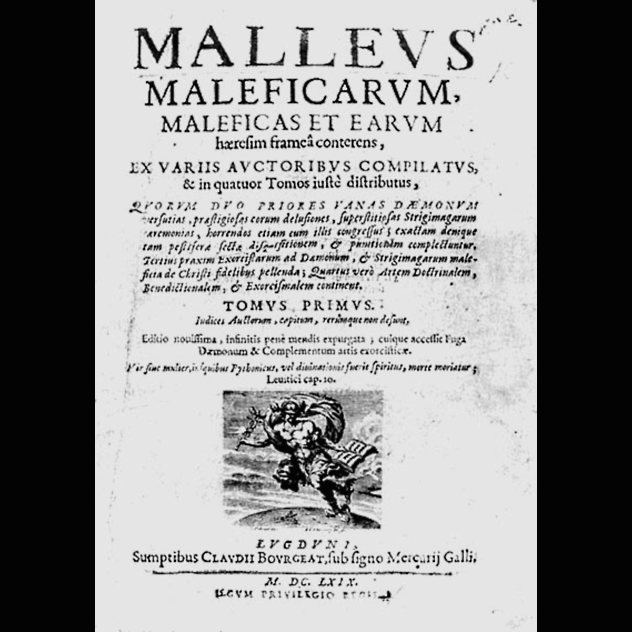 Weird Stuff
Weird Stuff  Weird Stuff
Weird Stuff  Health
Health Ten Confounding New Inventions from the World of Biomedicine
 Creepy
Creepy 10 Death Superstitions That Will Give You the Creeps
 Movies and TV
Movies and TV 10 Movies That Get Elite Jobs Right, According to Experts
 Weird Stuff
Weird Stuff 10 Times Real Laws Were Based on Bizarre Hypotheticals
 Animals
Animals 10 Inspiring Tales of Horses Being Human
 Mysteries
Mysteries Top 10 Haunting Facts About the Ghost Ship MV Alta
 History
History 10 Surprising Stories About the Texas Rangers
 Humans
Humans 10 Philosophers Who Were Driven Mad by Their Own Theories
 Miscellaneous
Miscellaneous 10 Video-Game-Worthy Weapons and Armors from History
 Weird Stuff
Weird Stuff 10 Warning Labels That Exist Because Someone Actually Tried It
 Health
Health Ten Confounding New Inventions from the World of Biomedicine
 Creepy
Creepy 10 Death Superstitions That Will Give You the Creeps
Who's Behind Listverse?

Jamie Frater
Head Editor
Jamie founded Listverse due to an insatiable desire to share fascinating, obscure, and bizarre facts. He has been a guest speaker on numerous national radio and television stations and is a five time published author.
More About Us Movies and TV
Movies and TV 10 Movies That Get Elite Jobs Right, According to Experts
 Weird Stuff
Weird Stuff 10 Times Real Laws Were Based on Bizarre Hypotheticals
 Animals
Animals 10 Inspiring Tales of Horses Being Human
 Mysteries
Mysteries Top 10 Haunting Facts About the Ghost Ship MV Alta
 History
History 10 Surprising Stories About the Texas Rangers
 Humans
Humans 10 Philosophers Who Were Driven Mad by Their Own Theories
 Miscellaneous
Miscellaneous 10 Video-Game-Worthy Weapons and Armors from History
10 Absurd Facts About History’s First Official Witch-Hunter
While The Last Witch Hunter got some pretty negative reviews, it’s nothing in comparison to Heinrich Kramer, the first witch-hunter to be officially sanctioned by the Catholic Church. Kramer, who was born around 1430 and died in 1505, was a German Dominican friar and a member of the Inquisition. As such, he traveled around, investigating potential heresies. It was his job to bring people back to the “true faith” of Roman Catholicism. If he couldn’t convince them to confess and repent, then he would punish them, usually by burning them at the stake. Kramer became particularly infamous for his torturous methods of “convincing” people and for his deep hatred of witches. He considered Satanic witchcraft a heretical “sect” and made it his personal mission to eradicate it from Europe. He was the first person to effectively instigate a full-blown crusade against witches.
When it came to witch-hunting, Kramer literally wrote the book on it. He was the author of a how-to manual for witch-hunters called the Malleus Maleficarum (Hammer of Witches). The Malleus, published in 1847, eventually became the main reference source for witch-hunters, to the extent that it has been referred to as “the witch-hunter’s Bible.” It was also without a doubt one of the most socially poisonous and paranoid books in all of history. By writing it, Kramer has been credited with indirectly causing the torture and brutal death of an estimated 40,000–50,000 people who were suspected of witchcraft during the period of the great witch hunts. Here are 10 notable absurdities from Kramer’s life and career.
10 He Was Given Free Rein By Pope Innocent VIII

The text of the Malleus shows that at the time it was written, people commonly believed that an all-powerful God would never allow witches to obtain the great power that men like Kramer attributed to them. Kramer therefore faced the problem of explaining why God allowed the Devil great power and why the Devil happily shared this power with the women who were supposedly seduced into serving him. In an attempt to convince more scholastic Catholic theologians, who condemned his book and recognized it as unethical and theologically unsound, Kramer added the name of a coauthor—Jakob Sprenger. Sprenger was a respected theologian, and the addition of his name was intended to add greater credibility to an otherwise dubious work.
Besides gaining Sprenger’s endorsement, Kramer also set out to convince the ironically named Pope Innocent VIII that Satanic witchcraft was rife throughout Germany and capable of causing great harm to people and the church. Unfortunately for hundreds of actual innocents throughout late Medieval Europe, Innocent granted Kramer and his witch-hunting cronies complete authority. The papal bull of 1484, Summis desiderantes affectibus, gave Kramer the power to go about his witch-hunting in and around Germany without obstruction or hindrance.
9 His Book Was Made Even More Effective By Popular Opposition

After obtaining his bull of authorization from the pope in 1484, Kramer’s next big move was to organize a witch hunt in Innsbruck, which began in July 1485. Previously, he’d met a lot of resistance from local priests, bishops, and magistrates, who’d objected to his tactics of intimidation and torture. They’d also found Kramer’s intense questioning of accused women distasteful due to his fixation on their sexual habits. Some had even refused to allow him to proceed with his work, but now that he had the backing of the pope, surely such obstructions would be a thing of the past.
The papal bull initially convinced Georg Golser, the bishop of Brixen, to go along with the witch hunt. Golser even handed out 40-day dispensations to anyone willing to help Kramer in his attempts to find and try witches. Many witnesses came forward to testify. There were 50 accused, and only two of them were men. Kramer collected written statements, which included a great variety of magical accusations. Much of this content would become the raw material for his soon-to-be-written Malleus. The courtroom experience that he gained from these trials enabled him to become more efficient at getting around due legal processes and more sophisticated in dealing with any local authorities who might use them to oppose him.
The actual trials at Innsbruck ran from August 9 to September 14. Interestingly, the accusers barely mentioned the Devil and never once mentioned witches’ highly sexualized Sabbats. Some claimed that they had been bewitched by dead mice and dung taken from the Jewish quarter. Golser became concerned about the way things were going, and he wrote to the archduke, asking him to restrict Kramer’s scope to serious bodily harm caused by witchcraft, as well as blasphemy. Nonetheless, Kramer charged seven of the accused women with witchcraft and began to interrogate them through torture. These torture sessions ran from October 4 through October 21.
The townsfolk were soon stirred into an uproar of outraged protest. Despite Kramer’s great ecclesiastical authority as an inquisitor with carte blanche from the pope himself, the citizens were on the verge of rioting. When Kramer inappropriately grilled one of the seven women in an attempt to tie her sexual behavior to sorcery, a defense lawyer was brought in on her behalf. This lawyer turned the trial on its head. The case was declared a mistrial, and all results were nullified.
Kramer was deeply affected by this defeat. Though the bishop suggested several times that Kramer should leave, he lingered as an intimidating and unwelcome figure until February the following year. After that, he skulked away, dogged by the rumor that he was losing his mind. He channeled his personal frustration and experience into the pages of Malleus, written in 1486 and published in 1487.
8 His Book Became A Popular, Posthumous Hit

The church’s inquisitors considered their work to be of vital importance. They were primarily concerned with trying serious heretics. The crime of heresy originally didn’t even include witchcraft, and inquisitors certainly didn’t want to be bothered by every petty local accusation. As the Malleus acknowledges, inquisitors often left things up to local secular and ecclesiastical authorities, who could fine, banish, or otherwise independently punish people suspected of witchcraft. The crime of sorcery in and of itself didn’t fall under the Inquisition’s jurisdiction.
The Roman church, although guilty of indulging Kramer’s insanity under the ruinous reign of Innocent VIII, never allowed him to fully realize his ambition of becoming Europe’s preeminent witch-hunter and perhaps even commanding his own elite witch-hunting order. Kramer’s infamous book, however, lived on to inspire the witch-hunting craze of the Reformation and Early Modern Period. Although both Catholics and Protestants got swept up in the frenzy, the Protestant schism seems, for some reason, to have been a primary cause of the explosion of witch trials during the 1600s and 1700s.
Kramer’s witch-hunting book, during his own lifetime, wasn’t really the “must-have” guide for medieval inquisitors that people sometimes imagine and that he himself would have liked it to be. Most of the witch-hunting that it inspired happened after his time. Unfortunately, the printing press had already been invented decades before the Malleus was written. It eventually became a popular best-seller among a growing Protestant readership, which had done away with the structure, authority, and experienced caution of Catholicism and who were now free to let their wildest fears and imaginings run berserk.
7 He Believed Witches ‘Changed’ People Into Animals

After discussing arguments by previous theologians, Kramer was forced to conclude that human beings couldn’t actually be transformed into animals nor be compelled by magic to inhabit the bodies of animals. These previous theologians, according to Kramer, also seemed to indicate that magic couldn’t create the illusion of someone being transformed into a beast, either. Nonetheless, the fanatical monk sidestepped this problem by managing to find a suitable loophole in the writings of his fellow Dominican, Antoninus. According to Antoninus, the Devil could indeed deceive people’s senses by conjuring illusions. Therefore, according to Kramer, so could witches. This was because angels—including Satan and all his demons—were of a higher, more powerful nature than physical beings. Since the human imagination and senses belonged to physical bodies, angelic beings were sometimes able to gain an influence over them. The witch-hunter quoted Antoninus:
It must not be omitted that certain wicked women, perverted by Satan and seduced by the illusions and phantasms of devils, believe and profess that they ride in the night hours on certain beasts with Diana, the heathen goddess, or with Herodias, and with a countless number of women, and that in the untimely silence of night they travel over great distances of land. [ . . . ] Wherefore priests ought to preach to the people of God that they should know this to be altogether false, and that when such phantasms afflict the minds of the faithful, it is not of God, but of an evil spirit. For Satan himself transforms himself into the shape and likeness of different persons, and in dreams deluding the mind which he holds captive, leads it through devious ways.
According to Kramer, witches were more than simply deceived by such illusions. They could intentionally create them as well, as was the case with the sorceress Circe from Homer’s Odyssey, who transformed the companions of Odysseus into animals. This supposedly happened in real life, too. The Malleus tells of a young man who became angered when his girlfriend rejected his sexual advances. He consequently paid a Jewish witch to work a vengeful spell that transformed his girlfriend into a female horse. She actually transformed, of course, since it was only an illusion perpetrated by the Devil upon the girl and upon everyone who happened to look at her. The same was true of husbands who began to see their wives as hideous, ugly creatures and vice versa.
6 He Believed Witches Performed Remote Penectomies

Illusion wasn’t the only transformative power believed to be at a witch’s disposal. According to the Malleus, witches could also transform men by magically removing their manhood. The removal of the male member wasn’t necessarily done by illusion, however. It could, in theory, be literally and physically removed by a demon. This was possible because God had sometimes used bad angels to punish people. In the Bible, for example, God punished Israel for their sins by sending them diseases, plagues, and so on. These weren’t illusions and actually afflicted the Israelites physically. God had even allowed Satan to afflict Job’s body with maddening boils just to prove a point, and Job hadn’t even done anything wrong. It was therefore likely that God would allow a demon to sever some fornicator’s or adulterer’s penis from his body.
In fact, God happily afflicted the genitals more than any other part of the body. This was because original sin had arrived through sex to spoil the entirety of God’s good creation. Moreover, hadn’t God used an angel to miraculously transform Lot’s wife into a pillar of salt? Likewise, the sex-obsessed Sodomites, back in the city that Lot’s wife had been so unhappy to leave (because she was also obsessed with sex), had been afflicted with blindness by the punishing angels. Therefore, by comparison, delegating the power of punitive penis-snatching to demons was a piece of cake for God.
However, according to Kramer, when penectomy was performed by witches, it was usually only a matter of illusion, although, “It is no illusion in the opinion of the sufferer.” He knew this because he’d examined many penises in such cases. The victim’s imagination “can really and actually believe that something is not present, since by none of his exterior sense, such as sight or touch, can he perceive that it is present.” This disturbing delusion was either affected through trickery, the use of hallucinogens, or the conscription of demons.
A person was able to tell if their missing penis was due to magical illusion only if the penis returned in time. If it didn’t return, then there was no way to determine whether the penis had actually been severed or whether a hiding spell was still operating. This was the case because some witches couldn’t undo the harm that they caused. They might also have moved away or died before removing the spell.
5 His Legacy Was Partly Built On Demonic Lettuce

Within the church, people couldn’t suddenly invent authority for relatively new beliefs and superstitions, even if those beliefs and superstitions were commonly held by people at the time. Tradition grew over centuries, and anyone seeking to establish new theological theories—such as the modus operandi of witches and how to capture, interrogate, convict, and punish them—had to be able to demonstrate precedence from scripture, canonical law, or the previous teachings of accepted church theologians.
The church had already established the idea that witchcraft was a form of paganism. As such, it had no actual power, or it was certainly powerless against Christ and the “true religion” of the church. Any perceived power in witchcraft was down to the imagination of misguided individuals. The Inquisition existed to try serious heretics, not misguided individuals, and that was a big problem for Kramer. Although Pope Innocent VIII eventually overturned canonical law in this regard, Kramer was still scrambling to find anything that might lend more authority to his witch-hunting guidebook.
Kramer found some of this much-needed authority in the writings about Gregory the Great, a former pope of Rome. In Book One, Chapter Four of the Gregorian Dialogues, the writer conveniently describes a Rome infested with witches and tells the story of a male witch, Basilius, who was driven out of the city. Basilius fled to Valeria, Spain, and joined a monastery against the abbot’s better judgment by recommendation of the bishop.
Basilius reportedly began to cause the abbot to levitate in his cell. After afflicting a beautiful nun in the attached convent with illness and causing her to beg for him to come and relieve her, Basilius was kicked out of the monastery as well, but presumably not before infecting the place with unclean spirits. Another nun from the same convent then saw an attractive lettuce in the garden. She greedily ate it before saying the customary blessing and was immediately struck with a painful fit. The abbot was called, and upon his arrival, a demon protested through the nun’s voice that it hadn’t done anything wrong and that it had only been sitting on the lettuce minding its own business when it had been consumed by the nun. The abbot was able to expel the demon, and Kramer was able to use this absurd story to lend credence to his ideas about witch-hunting.
4 He Thought Witches Hid Magical Charms In Their ‘Unmentionable’ Bodily Cavities

Kramer recommended specific precautions for anyone judging a witch. For example, they should wear a capsule of blessed salt around their neck, along with the consecrated seven words spoken on the cross by Christ. The witch was to be led in before the judge backward, if possible. According to Kramer’s experience, witches about to be tortured had been known to beg their jailers to be allowed to glimpse the judge prior to being seen by him. In this way, through being able to visualize him, they were believed to be able to magically change his attitude so that he would let them go free.
Another requirement was that the witch should not be able to physically touch the judge. Should she be allowed to do so, she could potentially inflict some harmful spell upon him or bewitch him into setting her free. She was also to be stripped and shaved all over her body, because witches were apparently in the habit of concealing charms about their person, even in “the most secret parts of their bodies which must not be named.” One such charm was reportedly made by a witch in the town of Hagenau from the ashes of murdered and roasted unbaptized children. It gave her the “power of silence,” so that she was able to avoid confessing her crimes.
Witches with this “power of silence” were said not to be able to shed tears. If the accused didn’t weep while being tortured, that was seen as a sure sign that they were guilty. This kind of magic made the judge’s job more difficult, “for some are soft-hearted, or even feeble-minded, so that at the slightest torture they admit everything, even some things which are not true; whereas others are so hard that however much they are tortured the truth is not to be had from them; and this is especially the case with those who have been tortured before, even if their arms are suddenly stretched or twisted.”
Special precautions were therefore to be taken in order to prevent accused witches from remaining silent. A witch at Issbrug, for instance, supposedly boasted that she could cast this silencing spell for any fellow witch that was undergoing torture, if only she could obtain a thread from the prisoner’s clothing. Another group of heretics, discovered in the Diocese of Ratisbon, were said to have miraculously survived both burning and drowning (to everyone’s great fear and astonishment) due to having sewn a silencing charm between the skin and flesh at the crease of their arms.
3 He Believed Witches Could Raise Storms With Bowls Of Urine

It wasn’t just lightning that witches could muster at will; they were also adept at conjuring bad weather. One vengeful witch from the town of Waldshut on the Rhine, who was later burned at the stake for her crimes, brought down a severe storm upon a wedding celebration that she had deliberately not been invited to. Typically, witches used bowls filled with water to produce these results. They would stir the water with their finger as a sign to the Devil that he should create a storm on their behalf. On this occasion, however, since the witch had been transported through the air by the Devil to a hill overlooking the town, she had no water with her. Under interrogation, she confessed to having urinated in a bowl instead.
Another witch, held for questioning in the Castle of Konigsheim near the town of Schlettstadt in the Diocese of Strasburg, was tricked into confessing her use of this method of storm conjuring by three of the castle’s household. They pretended that the castle’s owner had gone away on a journey, and they promised the witch that they would let her go free if she would only show them how to make storms. At first, the witch refused, rightly believing that they were trying to entrap her. But eventually, she agreed and asked for a bowl of water to be brought. One of the entrappers stirred it with his finger while the witch spoke an incantation, supposedly producing “such a tempest and storm of hail as had not been seen for many years.”
2 Traditional Trials By Ordeal Weren’t Witch-Proof Enough

Kramer’s cruel witch-hunting technique has now become infamous for its fatal double binds, whereby a person found guilty of sorcery could only be proven innocent by actually dying. A similar method employed in those days for better determining if someone was innocent or guilty of a crime was the trial by ordeal. In the regions toured by Kramer, “trial by red-hot iron” seems to have been the most popular ordeal. If the person under suspicion of a crime could carry a red-hot piece of iron three full paces without dropping it, they were deemed innocent. If they couldn’t, and they were accused of sorcery, then ipso facto, they must be a witch.
The problem with this judicial masterstroke of sadistic logic wasn’t that the average accused person would of course immediately drop the bar due to the agonizing, searing pain. Rather, according to Kramer, the problem was that the test actually became popular with witches, because the clever ones could use magic to cheat. In the Malleus, Kramer related an example of one such cheating witch:
An incident illustrative of our argument occurred hardly three years ago in the Diocese of Constance. For in the territory of the Counts of Fuerstenberg and the Black Forest there was a notorious witch who had been the subject of much public complaint. At last, as the result of a general demand, she was seized by the Count and accused of various evil works of witchcraft. When she was being tortured and questioned, wishing to escape from their hands, she appealed to the trial by red-hot iron; and the Count, being young and inexperienced, allowed it. And she then carried the red-hot iron not only for the stipulated three paces, but for six, and offered to carry it even farther. Then, although they ought to have taken this as manifest proof that she was a witch [ . . . ], she was released from her chains and lives to the present time, not without grave scandal to the Faith in those parts.
1 He Believed Witches Were More Evil Than Satan Himself

One of Kramer’s more radical theological assertions was that the witches he persecuted were in fact more evil than the Prince of Darkness himself. In the Malleus, he put forward a six-part argument as to why this was so:
Satan fell from his own angelic nature, but witches have fallen from grace:
Although the sin of Satan is unpardonable, this is not on account of the greatness of his crime, having regard to the nature of the Angels, with particular attention to the opinion of those who say that the Angels were created only in a state of nature, and never in a state of grace. And since the good of grace exceeds the good of nature, therefore the sins of those who fall from a state of grace, as do the witches by denying the faith which they received in baptism, exceed the sins of the Angels.
Satan is irredeemable, but witches aren’t. Therefore, they’re worse:
[Satan] sinned in his pride while there was yet no punishment for sin. But witches continue to sin after great punishments have been often inflicted upon many other witches, and after the punishments which the Church teaches them have been inflicted by reason of the devil and his fall; and they make light of all these, and hasten to commit, not the least deadly of sins, as do other sinners who sin through infirmity or wickedness yet not from habitual malice, but rather the most horrible crimes from the deep malice of their hearts.
Secondly, although the Bad Angel fell from innocence to guilt, and thence to misery and punishment; yet he fell from innocence once only, in such a way that he was never restored. But the sinner who is restored to innocence by baptism, and again falls from it, falls very deep. And this is especially true of witches, as is proved by their crimes.
Satan sinned against God alone, but witches sin against God and Christ:
[Satan] sinned against the Creator; but we, and especially witches, sin against the Creator and the Redeemer.
Satan has no pity from God, but witches do:
[Satan] forsook God, who permitted him to sin but accorded him no pity; whereas we, and witches above all, withdraw ourselves from God by our sins, while, in spite of his permission of our sins, He continually pities us and prevents us with His countless benefits.
The fifth argument essentially repeats the first two points:
When [Satan] sinned, God rejected him without showing him any grace; whereas we wretches run into sin although God is continually calling us back.
God is merely a “punisher” to Satan, but He’s a “merciful persuader” to witches:
[Satan] keeps his heart hardened against a punisher [God]; but we against a merciful persuader. Both sin against God; but he against a commanding God, and we against One who dies for us, Whom, as we have said, wicked witches offend above all.
+ He Became An Advocate For Women After Writing The Misogynistic Malleus

Since the 1970s, feminist scholars have pointed to Kramer’s witch-hunting guide as a preeminent example of the medieval church’s patriarchal misogyny. Kramer even dedicated a whole chapter of the Malleus to explaining why far more women became witches than men. According to him, it was because women were more prone to lust than men. The Devil used sex to entice women into the wild nocturnal orgies carried out during the witches’ ceremonies (which came to be known as “Sabbats”). Women’s wills were weaker. They were morally inferior to men, so they were more open to being seduced by Satan. They could then in turn be used by the Devil to seduce men.
Since the sexist and likely perverted Kramer had written such a book as the Malleus, a book that legitimized the vilification, brutal torturing, and killing of so many women, then according to feminists, he must have been motivated by a deep-seated fear and loathing of women in general. More recently, however, in a peculiar reversal, it now seems that Kramer may have (to some extent) been unfairly vilified. While there’s no doubt that his outlook was sexist, his views were commonly shared by everyone, including women themselves, during the period in which Kramer was writing. Moreover, scholar Tamar Herzig of the University of Jerusalem has now looked into other documents written by Kramer, which shed light on later events in his career and which show him to have been an advocate, as well as a persecutor, of spiritual women.
According to Herzig, these documents demonstrate that Kramer actually admired and possibly had close friendships with a number of Italian women in his Dominican order who had gained reputations as mystics. In his role as an inquisitor, he’d personally examined the miraculous stigmata of one such saintly woman and had testified that she was a genuine conduit of Christ. He’d also recommended several such women to certain heretics as sterling examples of virtue and of the kind of holiness that could only be attained through the sacraments of the church.
Kramer was somewhat unusual in all of this, since at the time, female mystics were becoming quite unpopular with the patriarchy. They were seen to be outdoing men in terms of piety. Pope Alexander VI (who replaced Innocent VIII and was probably even worse than his predecessor), was concerned that these women were becoming too influential. Some, like Catherine of Siena, had even meddled in politics and statecraft and had thereby played a hand in world-changing events. So in speaking out for such women, Kramer (although probably seeking to advance the Dominican order over the stigmata-hogging Franciscans) seems not to have been a total woman-hater, after all.
Though Kramer’s writings as a whole exhibit a traditional Madonna-whore complex, his main concern throughout seems not to have been the vilification of women but the vilification of heretics as Satanists. In another of his anti-heretical “guidebooks,” written after the Malleus and published in 1501, Kramer accused the members of a Waldensian offshoot sect of gaining diabolical wisdom by ingesting Satan in the form of flies (an absurd anti-Christian parody of the Eucharist). Since the members of these sects were pacifists, and they did not agree with torturing or burning anyone at the stake, the paranoid Kramer was conveniently able to accuse them of being witch sympathizers and “protectors” and also of being in league with the Devil.
HTR Williams is a big fan of the history of the occult and the psychoanalytic movement. Read more or follow him on Facebook.








